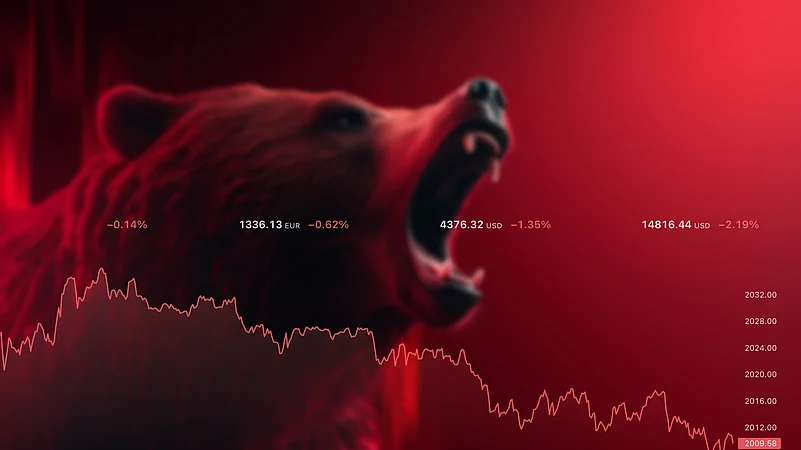Indian equity markets have been on a downtrend since September 2024, with a sharp correction witnessed across indices. The Sensex has shed over 10,000 points from its all-time high, and broader indices have followed suit, with sectoral corrections ranging from 15% to 30%.
According to Outlook Business analysis, more than 80% of the BSE 500 stocks are currently in bear territory, with over a fifth of their value lost from their 52-week highs. As of 20 February 2025, data shows that 403 stocks out of the BSE 500 have fallen by 20% or more from their respective 52-week highs. Prominent among these are Reliance Industries, Nestlé India, Bajaj Auto, State Bank of India, Zomato, etc.
The downturn has been driven by a combination of factors that have put investors on edge, including relentless selling by foreign institutional investors (FIIs), a record depreciation of the Indian Rupee, fears of global tariff wars, and a sluggish domestic economy. In addition, corporate earnings have weakened, further adding to the downward pressure on stock prices.
As the market continues to struggle from these factors, analysts are divided on whether the worst is behind us, with many suggesting it is still too early to call the end of the sell-off.
In 2025 so far, the benchmark indices Nifty 50 and Sensex have tanked over 3.6% each. While the broader indices, BSE Small Cap and Mid Cap, have plunged over 17% and 13%, respectively.
The sell-off has been witnessed cutting across sectors on the back of weak corporate earnings and a slowdown in GDP growth coupled with a declining trend in consumption. This Q3 earnings season saw a higher number of downgrades than upgrades. The combination of weak consumption and challenges from the commodities sector has weighed down earnings, despite strong performances in BFSI, Healthcare, Capital Goods, and Technology.
“Autos, commodities, energy, consumer durables, PSUs, and FMCG are some of the sectors that have experienced overall corrections ranging from 15% to 25%, clearly indicating that the weakness has been more at the broader level rather than the micro level. Even in sectors where the corrections have been less severe, such as IT and private sector banks, some companies within these sectors have also witnessed significant corrections over the past couple of quarters,” said Aamar Deo Singh, Sr. Vice President of research at Angel One.
“A tapering off of demand, a slowdown in economic growth, stagnant wages, and inflationary concerns have all contributed to the bearish trend,” Deo added.
“We do not find much value in most parts of the market despite the recent sharp correction in the market. The Indian market may stay lacklustre, weighed down by rich valuations across sectors and stocks, potential earnings downgrades, and higher-for-longer global interest rates,” Kotak Institutional Equities said in a recent research report.
“The 3QFY25 results season did little to change our cautious view of the market,” it added.
What Investors Should Do Now
While the market correction has been sharp, it’s important for investors to maintain a long-term perspective. Even though the bearish sentiment is prevalent, analysts suggest that investors should carefully evaluate the current market conditions and consider opportunities that could arise from the correction.
Krishna Appala, Sr. Research Analyst, Capitalmind Research says, it’s hard to predict when the bottom will come. Markets have seen a V-shaped recovery post-COVID, but it was short-lived. This time, a quick recovery is less likely. It looks like a base has formed, and it may take three to six months to get a clearer sense of the next direction. Larger capital seems in no rush to return to previous highs."
"While investors have seen a 16% fall on Nifty, 21% on Nifty Next 50, and individual stocks have fallen 25% to 35%, or even more in some cases, buying opportunities are definitely emerging. As a result, some very good stocks are now available at reasonable valuations, both on a TTM and one-year forward basis. When it comes to sectors, it's best to focus on individual stocks, but in general, sectors tied to Indian domestic consumption or themes like 5G appear promising at the moment," Appala said.
Triggers to Watch for Market Recovery
Historically, when negative news peaks, it often signals a good time to invest, as markets tend to price in all the negative factors well in advance, typically 4-6 months ahead. Despite the deep correction, the India VIX remains within reasonable levels, suggesting that investor sentiment isn't overly fearful at present. Moving forward, the next two quarters will be critical, with investors keeping a close watch on corporate earnings, the US Federal Reserve’s potential rate cuts, inflation concerns, and the impact of global trade tensions, according to analysts. Additionally, any signs of recovery in India’s consumption demand will be crucial for a market rebound.
Deo says, “Markets are known to be intelligent beasts, which are ahead of the news flows by at least 4-6 months. The next two quarters are going to be extremely crucial, as investors are focusing on corporate earnings and other key triggers, including global economic factors and India's domestic demand."





























